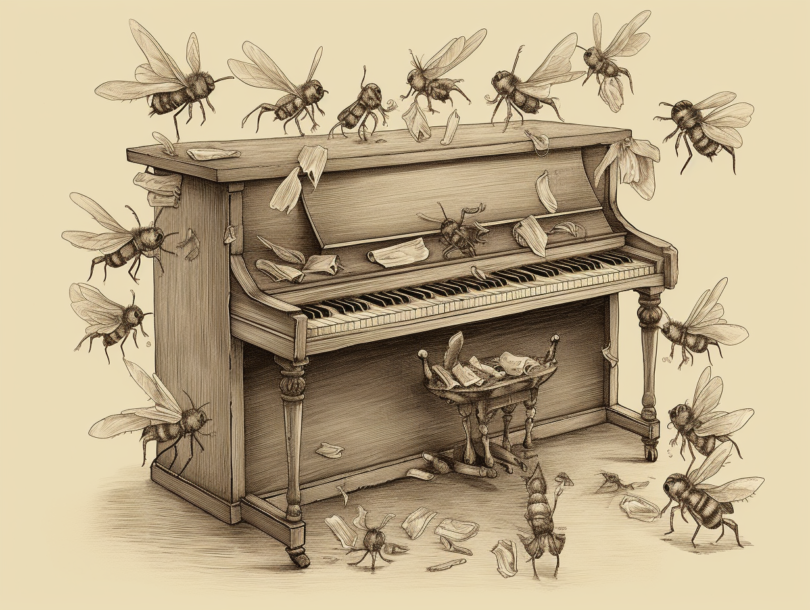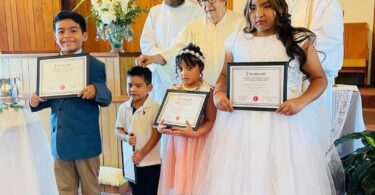A Short-(ish) Preface
This is a piece I wrote a few years back, in another life, in another church. It served more as a treatise against a controversy that is still on-going in that community today: worship!
To my knowledge, only one person in that congregation read this article. I poured my soul into a mission statement proclaiming the importance of worship … and only one person admitted that they read it. (At least they said they loved it!) So, who knows? Maybe, everyone else hated it … or even worse, maybe they just ignored it.
That said: please don’t think you have to say to me: “Oh I read your article and … I! Loved! It!” No ego is attached to anything I write, regardless of whether it’s loved, hated, or otherwise. It’s just that our Newsletter affords an excellent platform for you to hear from your pastor about things – good things, bad things, trivial things, things involving the life of the church, culture, or society, or anything else that happens to come to mind. As it happens, this week a good friend of mine is having a tough time navigating the importance of worship in his church context, and worship is something close to my heart.
Churches that worship well always tend toward growth. This DOES NOT mean that “good worship = people pleasing”, just so they’ll want to come back. No, it means good worship pleases the Holy Spirit, and it is the Holy Spirit that people keep coming back to experience. This year’s awakening at Asbury College in Wilmore, KY, is proof positive of this.
As a new church, I think that we’re doing remarkably well with our worship services. However, I do believe that so far as the logistics of church, worship is simply one of those things that tend to fall through the cracks, get side-lined, and sometimes get taken for granted. It’s kind of like learning to play a piano. Without practice, one can’t gain the necessary proficiency to master the notes or the chords, and without this skill, the demotivated musician tends to let the instrument fall into disrepair.
So: with all that said . . . I hope you enjoy this story. Maybe you will think about worship more. I certainly hope so. And before you ask, while this happened a long time ago, it’s all really true!
Early Days as a Minister
My first experience leading a congregation as a United Methodist pastor happened twenty-three years ago on a hot June afternoon. I had no clue what I was doing. Some may argue that I still don’t. It was the first Sunday of my first appointment as the new preacher on the Falkner charge. At that time, the charge consisted of 3 United Methodist Churches: Golden Hill, Falkner, and Friendship. Way back then, I was a young man: plus or minus thirty years old, overly enthusiastic, naïve, and ready to give the devil his due. My mission? Change the world in the name of Christ!
Oh, how I long for that naïve sense of faith now. While they were hard, I remember those years as some of the best. I was too young and dumb, as they say, to fully grasp the complexity of a pastor’s life or the challenges of leading a parish. Unfortunately, church has a way of grinding pastoral joy to dust if one is not careful. If a preacher forgets to stop reflect on the value of hard-fought lessons, the flame dies out quickly. It is one of these lessons that I want to share with you here. It began on my very first day as a preacher. But it’s only been in recent years that I’ve come to understand the value of what this lesson continues to teach me today.
I remember my first day on the job as a preacher like it was yesterday. It was a sweltering day in late June, with giant cumulus clouds looming, shoulder to shoulder, from one end of the sky to the other – the kind of day where folks say things like this: goan blow up a stome d’rctly! The title of my first ever sermon was: “Children of Hypocrisy.” At some point over the years, the notes for that sermon seem to have gone missing—thankfully.
I don’t remember how the services went at Falkner and Golden Hill, though I suspect given the ill-fated title of that first sermon and the fact that I knew neither how to preach nor sing (yep, no song leader, just little ol’ me), they probably didn’t go too well. I remember people smiling, nodding, and shaking my hand after the services. Every good churchgoer loves trying to be nice.
Broken and Cracked Ivories
But there is one significant thing that happened at Friendship. Now to understand what I am about to say, context is necessary. All those years ago Jack Nabors – God rest his soul – was the District Superintendent for the New Albany District. After long months of working through the candidacy process for ministry, I suppose Bro. Jack, in all his infinite wisdom, thought I could handle an appointment. So, through due process and proper Methodist protocol, my wife and I found ourselves in a covenant meeting at Falkner UMC with representatives from all three churches.
Now, something else to know is that my wife (hereinafter, “Mrs. Kay”) is an accomplished piano player. Even though she claims not to be, the truth is, she plays quite well. Did I mention that none of the churches had a piano player? Bro. Jack sure did! In fact, he jokingly said (or hinted?) that Mrs. Kay might have to play for these churches on Sunday mornings.
The problem is, Bro. Jack jokingly mentioned this during the covenant meeting. Well of course, they (meaning the representatives from the churches) took that little tid-bit of humor and ran with it like breaking news! From that point on, if there was music accompanying the hymns anywhere on the Falkner Charge, it was only because Mrs. Kay was tickling the ivories at each church, which brings me to the most vivid of memories: broken and cracked ivories.
A Remote Church
On that hot June day, with heat-thunder rumbling in the distance, Mrs. Kay and I stepped inside Friendship UMC in Benton County. The church is located just off Hwy. 371 outside of Ashland. Take a left turn on to Friendship Road, and the church is about a mile down on the edge of the Holly Springs National Forest (yes, right where the pavement yields to gravel and sand). In those days, the church was nothing more than a cinderblock crown on top of a hill. Its steeple signaled the intended purpose of the building, but as I soon learned, looks can be deceiving.
The building was surrounded by woods and brush on both sides. It had a small cemetery just a few yards away. Sagging mismatched boards which looked like makeshift tables were nailed between several trees to the right side of the church. I found out later that these were the remnants of dinner on the grounds from long forgotten homecomings. Behind the church was the shell of an old outhouse that was (thankfully) long since out of commission.
Despite the heat outside, the inside of the church was remarkably cool. This was fairly surprising given that the air conditioner, which hung from a window opening all crooked and tilted, wasn’t even plugged in. The sanctuary smelled like years of musty neglect. Twelve leery onlookers craned their necks as we walked in. They smiled and said “Hhheeeyyy,” in the usual Southern drawl. Only a couple of people made the effort to get up and shake our hands. The whole experience was . . . shall we say . . . awkward!
Not to be dissuaded, I instinctively did what any preacher would do. I started walking around politicking! I shook hands with folks. I introduced myself and Mrs. Kay. I exchanged all the normal pleasantries. Where are we from? New Albany. Do I work? Not if I can help it (blah ha, ha)!! Yep, that’s right. Action Furniture in Saltillo MS. Mrs. Kay? Yes, she works at the Bank of New Albany. That’s right. . .she counts money for a living (blah ha, ha), and no, she’s never brought any of it home with her!
And that’s how it went for just a little bit until I went down front, got behind the podium, and introduced myself again as Dan Darling their new preacher. . . blah, blah, blah. . . I can just picture myself up there now talking louder than usual: overcompensating for the nerves in my stomach and the twitching in my knees. For some weird reason that escapes me now, I happened to notice a lizard make its escape under a door just off to the side of the pulpit. I got distracted and stammered more than I already was.
Time for a Hymn
And now came the fateful question — the reason for what brings us to these very pages! I asked: “Do you have any hymns picked out?” Everyone just kind of looked at each other, not saying anything. Did they know what hymns were? Surely, they did? Another one of those awkward moments. After a few excruciating seconds, a lady (who I discovered later was one of God’s true saints) picked up a worn copy of “Heavenly Highways,” and blurted out “Vic’try n Jeeesusss, nm’br foty-foe!”
“Ok,” I said. Mrs. Kay was sitting on the front pew, doing her best to avoid my gaze. Another awkward moment. She knew what was about to happen — again. Finally, our eyes locked, but not for our zeal or passion or shared love of the Lord. Nope! It was one of those if looks could kill moments … what I’ve come to learn over the years are “DEATH GLARES!” It was the same glare that myself and my sons would get at home when something didn’t go to suit her. The boys always start humming the Darth Vader tune from Star Wars whenever we catch that look. I wanted to say ‘Thank Jack Nabors,” but thought better of it.
Without a word, without a sigh, Mrs. Kay got up and went to the piano – and here is another one of those contextual things. Piano is a subjective term. There was a large wooden box there to the side of the pulpit. It was in the shape of a piano (I would find out later an upright grand piano). It had a piano bench that wabbled left and right when Mrs. Kay parked herself on it. It had a lid over the keyboard that was hard to open and kept catching on one side. After wrestling with it for a few seconds, Mrs. Kay forced it open, and the lid never closed again. It had keys with real ivory overlays which speaks to the age of the thing. Its brass pedals protruded at the bottom in typical piano fashion.
Mrs. Kay turned to page forty-four in her copy of “Heavenly Highways.” And of course, the pages were loose because the binding of her copy was tattered and torn. So, “Victory in Jesus” un-victoriously fell to the floor under the piano bench. DEATH GLARE! Rather than risk her falling off the piano bench trying to grab all the loose pages, I handed my hymnal to Mrs. Kay and grabbed another one off a shelf behind the podium. After quickly opening to page forty-four, Mrs. Kay lit in to the keys to strike out those first few notes accompanied by “I heard an old, old story. . .”
Victory in Clunk Clunk
But wait! Something didn’t sound right. It was as if some of the tune had been replaced by a loud “I heard an old—clunk, clunk. . .clunk—how a Savior came from—clunk, clunk. . .” The clunks resonated from somewhere deep inside the piano. Kay immediately stopped. I could hear the Darth Vader song in the back of my mind. The saint who picked the song piped up and said: “Sometimze duh keys dohn’t werk.” She offered a slight chuckle. “Try hittin’ em a liddle hawda nex time.”
Here’s another one of those contextual things. Mrs. Kay has always been very up front with the truth that she didn’t knowingly marry a preacher. And true enough, I was a lot of things when she and I married, but a preacher? A preacher I was not. That came a little later. But now I was wondering would she stay married to me? What good woman under the sun would sign up for these kinds of shenanigans?
Thankfully, Mrs. Kay’s stuck around so far. And she has always been a true and faithful ministry partner, proven, in fact, by what happened next. Without a word, Mrs. Kay lit into the keys again to strike out those first few notes of “Victory in Jesus.” Only this time, it wasn’t with the ease of her delicate fingers manipulating the keys to coax the tune out of the piano. No, this might as well have been Mike Tyson vs. Michael Spinks. In the second round, the song still didn’t sound right. The piano was, obviously, out of tune. And the “clunk, clunk. . .clunking” had yielded to faint pings that had probably once sounded like notes, but there was some semblance of “Victory in Jesus” going on, though it was the young-calf-in-a-hail-storm version.
And then, very abruptly, Mrs. Kay stopped playing!
Unexpected Guests
I looked over to see what was going on now. She had gotten up from behind the piano and took a couple of steps back. What in the world, I thought to myself. Thankfully Mrs. Kay wasn’t looking at me with her customary DEATH GLARE, but she did appear to be ill-at ease. I noticed her looking at the top of the piano with a perplexed look that boarded on fear. And as I looked harder, I saw why.
WASPS! Wasps were crawling out of some unknown opening at the back of the piano and buzzing around the top. I looked over at our saint who just chuckled and shrugged her shoulders, as if this passed for normal. The seconds that Mrs. Kay and I stood there looking at the piano were excruciating. While surely we had been amped up and nervous about this first day of preaching, never in my wildest dreams did I picture this happening. This situation wasn’t what I imagined preaching to be!
I started to say to Mrs. Kay: “We can sing it without. . .” But before I could finish, Mrs. Kay interrupted me with: “Nope, let’s keep going.” And so, she sat back down behind the piano. The bench continued to shift to the right and left as she moved her hands and arms. She soldiered on, not to be defeated, and knowing my Mrs. Kay like I do, it should be more aptly stated, not to let her God down!
As I think back on that moment now, I can honestly say that no wasp ever alighted on her or even made an attempt to. They kept to the back of the piano, buzzing around, as if they were part of the worship. Maybe they enjoyed the music.
Idle Worship
Now, you might ask, what’s the point in all this? Well, it’s something specific that I remember about the piano. You see, the piano had cracked and broken ivory that overlayed the keys. Not all of them, but most. Some of them were missing the ivory altogether.
Think of the sequence of things I’ve just told you. First, the lid to the piano would not open. In fact, as Mrs. Kay wrestled with it, no one even thought to mention that the lid was stuck. Had it been that long since anyone had attempted to sit behind the piano to play it? Second, did they know that the piano bench was on the verge of collapsing? Third, had this piano been so idle, for so long, that no one knew that a few of the keys made no noise at all when struck? Fourth (and again) had this piano been SO IDLE, FOR SO LONG, THAT WASPS nested in it and took up homesteading?
It was a sad thing, that piano. A few years ago, I went back to Friendship to preach one night of revival. By then, there was a new wing that had been added to the church, anew fellowship hall, new Sunday School rooms. Another piano now rings out loud and proud in the sanctuary. And the old one? It’s still there, pushed to the side in the new wing with the lid perpetually open, its cracked and broken ivory frozen in a perpetual grimace. As I think about the sad state of that old instrument, it occurs to me that a piano that can’t be played is like a creature born to run made legless, or a boat that was made for the high seas but remains tethered to the shore.
I wonder. . .does this describe the state of worship in our faith communities? Has complacency left us cracked and broken? Could we be characterized by the ivory on an old, neglected piano?
Keeping the Spirit of Worship Alive
Just the other day I was talking to someone about worship in the church. The overture this individual opined about their church is nothing new under the sun: how things used to be back in the “good ol’ days,” when the music was lively, and everyone sang along. If that’s true, then what happened? And what does this say about our attitudes towards Jesus, the one we are at church to worship in the first place? How can people claim to be Christ followers if it isn’t within them to sing for Jesus and to Jesus?
As I think about all the faces I’ve gazed upon over the years during countless worship services, I’ve often wondered, do they get it? I mean, are they only at church because they feel like they have to be? Do they understand church, or do they think of it as if church is a casual habit instead of a raging fire – something that can only be quenched by more church, more worship?
Ask yourself this question: What is worship? Something we do at church? Hymn singing? Liturgy? Testimonies? Preaching? Sacraments?
Robert Webber breaks down the definition of worship to the simplest of terms: “It’s a verb.” In fact, Webber has an incredible book bearing that namesake: Worship is a Verb. For Webber, worship involves preparation for movement into the heart space where we encounter God — where we hear God speak, we listen to God’s story, we see ourselves in God’s narrative, and we respond to what we have experienced in those precious moments. But even still, worship goes much deeper than that.
As Webber notes, “Worship has to do with our heart, our interior person, our longing for God, and our openness to His Spirit.” Webber additionally says that Christian worship mirrors Hebrew worship. Both are ways that God renews His covenant with us. Through worship, our relationship with God becomes more intimate through this renewal process.
Constance Cherry rounds out this point well. Cherry’s book “The Worship Architect” is fairly “text-book’ish” and deals with worship design as opposed to Webber’s simpler theology of worship, but I like how Cherry explains the true nature of worship: “Worship that is grounded in God acknowledges that God initiates worship. God invites us to worship. Worship is an invitation, not an invention that depends on us”.
A Scriptural Perspective on Worship
While I can appreciate both Webber’s and Cherry’s insights, what does the Bible say on the matter? Do you remember the time that Jesus was in Sychar in Samaria? You know, where He encountered the Samaritan woman at Jacob’s well? A thirsty Jesus parleyed with this woman about earthly water versus living water, her marital past, and then, remarkably enough, a very profound statement about the present reality of things, and of things to come.
“Woman, believe me, the hour is coming when neither on this mountain nor in Jerusalem will you worship the father. You worship what you do not know; we worship what we know, for salvation is from the Jews. But the hour is coming, and is now here, when the true worshipers will worship the Father in spirit and truth, for the Father is seeking such people to worship him. God is spirit, and those who worship him must worship in spirit and truth” (English Standard Version, John 4:21–24).
What happens when, for any reason, we fail to give our best attempt to worship the Living God? Slowly but surely the dust settles in, the strings get out of tune, the keys start clunking, the wasps move in, and the ivory cracks and breaks.
I’m reminded of something we find in Job. If you recall, in chapter 38, God answers Job’s complaint by saying:
“Who is this that darkens counsel by words without knowledge? Dress for action like a man; I will question you, and you make it known to me. ‘Where were you when I laid the foundation of the earth? Tell me if you have understanding. Who determined its measurements—surely you know! Or who stretched the line upon it? On what were its bases sunk, or who laid its cornerstone, when the morning stars sang together and all the sons of God shouted for joy?'” (Job 38:2–7).
When the morning stars sang together and all the sons of God shouted for joy. Should we be silent while the heavens create such a racket for God? Luke reports that as Jesus was riding into Jerusalem on a colt, the Pharisees who were present admonished him to silence the vast crowd of followers who had turned up to give Him praise. Jesus’s response? “I tell you, if these were silent, the very stones would cry out” (Luke 19:28–40). Angels, stars, rocks, wasps. . .and sometimes even a few people, all worship God. The entire cosmos itself is in constant adulation of its Creator. And we should be too.
So, come Sunday! Sing loud! Sing so loud that your throat burns and you find yourself gasping for breath! Join the cosmic chorus in its adulation of the One True God!
References for the Interested
- Cherry, Constance M. The Worship Architect: A Blueprint for Designing Culturally Relevant and Biblically Faithful Services. Baker Academic, 2010.
- The Holy Bible: English Standard Version. Wheaton, IL: Crossway Bibles, 2016. Print.
- Webber, Robert E. Worship Is a Verb: Eight Principles Transforming Worship. 2nd ed, Hendrickson Publishers, 1996.




